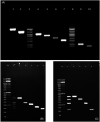Multiplex size marker (YEAST PLEX) for rapid and accurate identification of pathogenic yeasts
- PMID: 35318737
- PMCID: PMC9102616
- DOI: 10.1002/jcla.24370
Multiplex size marker (YEAST PLEX) for rapid and accurate identification of pathogenic yeasts
Abstract
Background: Multiple yeast species can cause human disease, involving superficial to deep-seated infections. Treatment of these infections depends on the accurate identification of causative agents; however, reliable methods are not available in many laboratories, especially not in resource-limited settings. Here, a new multiplex assay for rapid and low-cost identification of pathogenic yeasts is described.
Methods: A two-step multiplex assay named YEAST PLEX that comprises of four tubes and identifies 17 clinically important common to rare yeasts was designed and evaluated. The set also provides PCR amplicon of unidentified species for direct sequencing. The specificity of YEAST PLEX was tested using 28 reference strains belonging to 17 species and 101 DNA samples of clinically important non-target bacteria, parasites, and fungi as well as human genomic DNA. The method was further analyzed using 203 previously identified and 89 unknown clinical yeast isolates. Moreover, the method was tested for its ability to identify mixed yeast colonies by using 18 mixed suspensions of two or three species.
Results: YEAST PLEX was able to identify all the target species without any non-specific PCR products. When compared to PCR-sequencing/MALDI-TOF, the results of YEAST PLEX were in 100% agreement. Regarding the 89 unknown clinical isolates, random isolates were selected and subjected to PCR-sequencing. The results of sequencing were in agreement with those of YEAST PLEX. Furthermore, this method was able to correctly identify all yeasts in mixed suspensions.
Conclusion: YEAST PLEX is an accurate, low-cost, and rapid method for identification of yeasts, with applicability, especially in developing countries.
Keywords: Candida; identification; multiplex PCR; yeasts.
© 2022 The Authors. Journal of Clinical Laboratory Analysis published by Wiley Periodicals LLC.
Conflict of interest statement
The authors declare that the research was conducted in the absence of any commercial or financial relationships that could be construed as a potential conflict of interest.
Figures


References
-
- Aydin M, Kustimur S, Kalkanci A, Duran T. Identification of medically important yeasts by sequence analysis of the internal transcribed spacer and D1/D2 region of the large ribosomal subunit. Rev Iberoam Micol. 2019;36(3):129‐138. - PubMed
-
- Cortegiani A, Misseri G, Chowdhary A. What’s new on emerging resistant Candida species. Intensive Care Med. 2019;45(4):512‐515. - PubMed
-
- Colombo AL, Júnior JN, Guinea J. Emerging multidrug‐resistant Candida species. Curr Opin Infect Dis. 2017;30(6):528‐538. - PubMed
-
- Tortorano A, Peman J, Bernhardt H, et al. Epidemiology of candidaemia in Europe: results of 28‐month European confederation of medical mycology (ECMM) hospital‐based surveillance study. Eur J Clin Microbiol Infect Dis. 2004;23(4):317‐322. - PubMed
MeSH terms
Substances
Grants and funding
LinkOut - more resources
Full Text Sources
Molecular Biology Databases

